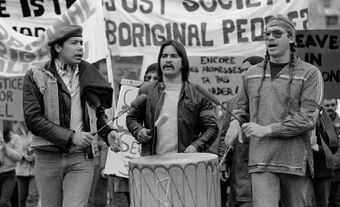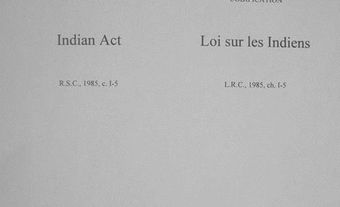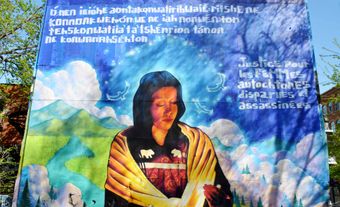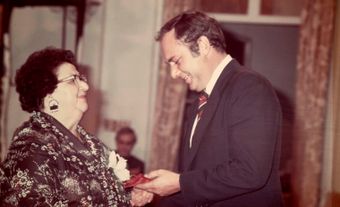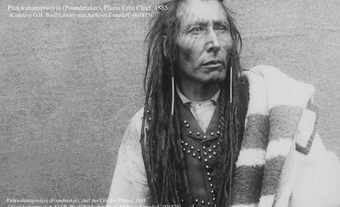The Indian Act has affected Indigenous cultures, systems of governance, societies and ways of life since its enactment in 1876. Gender discrimination in the Act further disadvantaged First Nations women, in particular. Until 1985, women with Indian status who married someone without status lost their status rights. Men, on the other hand, did not lose Indian status in the same way. Even after Bill C-31 reinstated the status rights of many women in 1985, the Act still discriminated against women by privileging male lines of descent. Amendments in 2011 and 2017 sought to fix these issues. In 2019, the federal government brought into force the remaining part of Bill S-3, which is meant to address lingering sex-based inequities in the Indian Act. (See also Indigenous Women’s Issues.)

Indian Act: 1876 to 1951
In 1876, the Indian Act defined an Indian as, “any male person of Indian blood.” Indian status was passed through the male bloodline, meaning that the children of Status Indian men also had status rights under the Act.
The Indian Act disadvantaged women and female lines of descent. Status Indian women lost their status rights if they married a man who did not have status, as would their children. However, a Status Indian man could marry a non-status woman and retain his status. In fact, the woman in that relationship would gain status rights, as would their children.
The Act also denied women power in other ways. For example, it prohibited women from participating in the band system — the new system of governance implemented by the Indian Act. The band system replaced Indigenous models of governance, some of which were inclusive of Indigenous women. Additionally, the Act denied women the right to possess marital property. If a woman’s husband left or divorced them, the woman could not stay in the marital home. In 1884, the Act was changed to allow men to leave marital property to their wives in their will. However, before this transaction could take place, an Indian agent would have to ensure the “good moral character” of the wife.
A New Indian Act in 1951
After the Second World War, the Canadian government consulted with First Nations communities through a Joint Committee process for the first time ever to bring about changes to the Indian Act. A new version of the Act was given royal assent in 1951. The resulting overhaul removed some of the most offensive political, cultural and religious restrictions. For example, bans on ceremonies like the potlatch and Sun Dance were removed. For First Nations women, the 1951 Indian Act meant they were now able to vote in band council elections. Elsie Marie Knott was the first elected female First Nations chief in Canada. (See also Indigenous Women and the Franchise.)
However, the new Act did not improve the terms of Indian Status for women. In 1951, the Act replaced the concept of “Indian blood” with one of status through registration. In other words, simply having First Nations heritage was not enough to qualify for status. Male lines of descent were still privileged. As section 12 (1)(b) of the Indian Act stated, “a woman who married a person who is not an Indian… [is] not entitled to be registered.” Women who married a non-status man still lost their status rights, as did their children. One of these rights was the right to own and inherit property on reserves. Furthermore, the 1951 Act introduced the “Double Mother” clause (sometimes called Double Mother rule) which takes away status from a person whose mother and grandmother acquired status through a marriage.
Outraged by the gender discrimination in the Indian Act, many Indigenous women fought to regain their status rights. Mary Two-Axe Earley was one of the earliest activists. In addition to other work, she mobilized a series of speaking and writing campaigns to raise the profile of abuses by women who had been denied status, treaty and property rights under the Act. Yvonne Bédard and Jeannette Corbiere Lavell, both of whom lost their status because of a marriage, brought cases to court against the Canadian government. In 1973, their cases merged at the Supreme Court of Canada. In that year, the court was widely criticized for ruling that the provision tying a woman’s status to her husband’s did not discriminate against women, even though status men kept their status if they “married out.” (See also Bédard Case and Lavell Case).
In 1981, the United Nations Human Rights Commission ruled that Canada had violated Article 27 of the International Covenant on Civil and Political Rights in the case of Sandra Lovelace Nicholas — a Wolastoqiyik woman who had lost her status through marriage. The government had prevented Sandra from returning to her home community because, according to the Indian Act, she had married out and was no longer considered to be a band member.
The efforts of women like Two-Axe Earley, Bédard, Lavell and Lovelace Nicholas were central to the revisions of the Indian Act that took effect in 1985.
Bill C-31: 1985 Amendments
In 1985, Bill C-31 amended the Indian Act to remove gender discrimination and bring it in line with the Canadian Charter of Rights and Freedoms. The amendment allows women who married out — and those who by other means lost their Indian status and accompanying rights and benefits — to apply for the restoration of their status and rights, and also allows their children to apply for registration as Status Indians. The Act no longer requires women to follow their husbands into or out of status.
Since the implementation of the amendments to the Indian Act in 1985, the number of registered Indians has more than doubled, from approximately 360,000 in 1985 to more than 778,000 in 2007. The increase is a result of more births over deaths as well as through "reinstated" Indian status.
However, while the amendment addressed discrimination against women, it also created some problems. By placing these women, and often their children, onto First Nations band membership lists, the government stretched already limited lands and funds to serve more people. This has, at times, caused resentment and backlash toward these people by First Nations members.
Further, Bill C-31 created two categories of Indian registration that have had consequences on the number of people entitled to Status Rights. The first, known as section 6(1), applies when both parents are or were entitled to registration. (This section is further broken down into sub-sections that differ based on how status is passed down.) The second, known as section 6(2), applies when one parent is entitled to registration under 6(1). Status cannot be transferred if that one parent is registered under section 6(2). In short, after two generations of intermarriage with non-status partners, children would no longer be eligible for status. This is known as the “Second-Generation Cut-Off” rule.
Moreover, in order for a child to be registered, both the mother’s and father’s names must be included on the birth certificate. If the father’s name is not included, he is assumed to be non-status. In such situations, children born to women registered under section 6(2) are not eligible for status. The amendment therefore significantly limits the ability to transfer status to one’s children.
Bill C-3: 2011 Amendments
Women continued to fight against gender discrimination in the Indian Act. One of these women was Sharon McIvor. She had her status reinstated under section 6(1)(c) of the 1985 Indian Act. McIvor’s son, however, had status under section 6(2), meaning that he could not pass on status to his children. McIvor argued that this was discriminatory. Her children’s status rights are not equal to those of a man with status, simply because she is a woman. McIvor’s grandchildren also would not receive status under the Act.
Bill C-3 was the government’s response to the McIvor case. It grants 6(2) status to grandchildren of women who regained status in 1985. However, Bill C-3 did not completely rid the Act of discrimination. The descendants of women, specifically in terms of great-grandchildren, did not have the same entitlements as descendants of men in similar circumstances. Therefore, some individuals were still denied status rights because of gender discrimination.
Bill S-3: 2017 Amendments
Bill S-3 was created in response to another court case about discrimination in the Indian Act, the 2015 Descheneaux case. The issue in this case was about the way status is passed to cousins and siblings.
One part of Bill S-3 came into effect on 22 December 2017. Among other provisions, the amendment enables more people to pass down their status to their descendants and reinstate status to those who lost it before 1985. For example, it provides ways to register people with unknown paternity and who were unmarried minors between 1951–85 and affected by registration rules in place at the time.
The other part of the bill — related to restoring status to women and their offspring who lost status before 1951 (known as the “1951 Cut-off”) — was brought into force on 15 August 2019. According to the government, “All known sex-based inequities in the Indian Act have now been addressed.”
Significance
First Nations women in Canada have long been disadvantaged and marginalized by the Indian Act. Through the leadership of women like Mary Two-Axe Earley, Yvonne Bédard, Jeannette Corbiere Lavell, Sandra Lovelace Nicholas and Sharon McIvor, the Act has become more inclusive and fairer.
However, the Indian Act is still problematic for many Indigenous peoples because it continues to define Indian status. While some Indigenous peoples believe that Indian Status has a legitimate place in federal law, others give it less value because status is a legal identity defined and imposed by the federal government rather than by Indigenous nations themselves.

 Share on Facebook
Share on Facebook Share on X
Share on X Share by Email
Share by Email Share on Google Classroom
Share on Google Classroom
